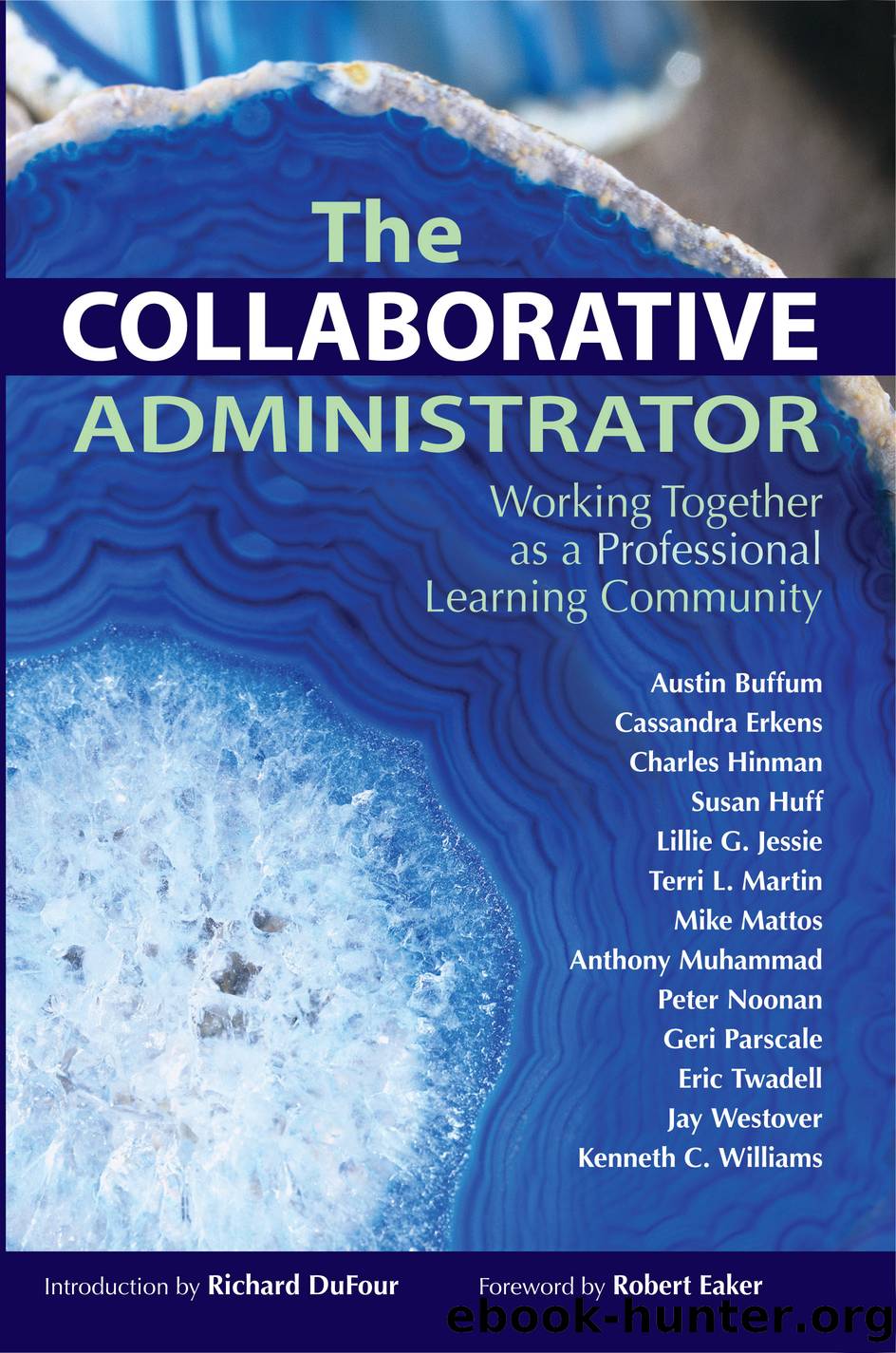The Collaborative Administrator by Buffum Austin;Erkens Cassandra;

Author:Buffum, Austin;Erkens, Cassandra;
Language: eng
Format: epub
Publisher: Solution Tree
Published: 2008-08-15T00:00:00+00:00
Creating an Internal Focus
It is understandable if school leaders get a migraine headache when thinking about the task of convincing educators that they need to improve their levels of knowledge and skill. Traditionally, the teacher is the authority in his or her classroom. Students are responsible for listening to the teacherâs instruction, participating in the teacherâs activities, and performing tasks outlined by the teacher, all with the goal of pleasing the teacher. The students who do this well are generally rewarded with pleasing evaluations, while the students who do not are punished through feedback that summarizes the displeasure of the teacher. This system creates a polarized effect that creates a group of âwinnersâ and âlosersâ based on compliance with teacher expectations, which may not always be centered on learning.
The traditional paradigm demands that student behavior adjust to better fit the teachersâ expectations (Cuban & Tyack, 1995). This rigid system has been the guiding educational paradigm for over a century, and there have been many attempts to alter it, with little to no success. Administrators have traditionally managed the school with the agreement that the teachers lead their classrooms, and the administrators manage the organization. This unspoken pact is deeply rooted in the culture of the traditional school.
In some schools, leaders face additional, institutional barriers. Many collective bargaining agreements restrict the focus of school meetings and professional development days set aside for teacher improvement. In fact, many collective bargaining agreements allow educators to use sick days or personal days to opt out of bargained professional development. In other cases, leaders have limited human and financial resources for professional development. Leaders in areas with high percentages of minority and socioeconomically disadvantaged students face the added challenge of high teacher turnoverâeven more than the average school, which experiences a teacher exodus of 50% within the first 5 years of classroom practice (Emerick, 2005). So how does a leader demonstrate instructional leadership when organizational structure is inflexible, funds are low, and a constant stream of new teachers must be retaught the skills lost when experienced staff leave the school community?
All of the barriers listed above, both cultural and institutional, make the job of leading schools very difficult. It is easy for school leaders to be sidetracked by all of the management tasks that cross their desks on a daily basis. It is easy to become distracted by parental issues and managing the many mandates handed down by state and federal agencies. But the overwhelming body of knowledge available in the educational research community dictates that a focus on adult learning is a non-negotiable, necessary component of improving student learning.
Download
This site does not store any files on its server. We only index and link to content provided by other sites. Please contact the content providers to delete copyright contents if any and email us, we'll remove relevant links or contents immediately.
Macmillan Primary Grammar 2 Pupil's Book by Unknown(391)
Figuring Out Fluency in Mathematics Teaching and Learning, Grades K-8 by Jennifer M. Bay-Williams & John J. SanGiovanni(356)
The Principal's Guide to Curriculum Leadership by Sorenson Richard D.;Goldsmith Lloyd M.;Mendez Zulma Y.;Maxwell Karen T.;(284)
English Grammar Practice--The Noun by Roxana Nastase(243)
Learning from Accidents 3rd ed by Trevor Kletz (2001)(242)
Harnessing Technology for Deeper Learning by Scott McLeod(234)
Text-Dependent Questions, Grades K-5 by Douglas Fisher & Nancy Frey & Heather Anderson & Marisol Thayre(218)
A Guide to Curriculum Mapping by Hale Janet A.;(218)
English Language Program Administration by Unknown(208)
How to Do Everything with Google Tools by Unknown(203)
Deep Change Leadership by Reeves Douglas;(198)
The Grammar Teacher's Activity-a-Day by Jack Umstatter(187)
The Power of SMART Goals by Conzemius Anne;O'Neill Jan; & Anne Conzemius(186)
Aligning and Balancing the Standards-Based Curriculum by Squires David A.;(166)
Beyond the RTI Pyramid by Bender William N.;(165)
Using Data to Close the Achievement Gap by Johnson Ruth S.;(160)
Differentiated Instructional Strategies for the Block Schedule by Gregory Gayle H.;Herndon Lynne E.; & Lynne E. Herndon(157)
Using Equity Audits to Create Equitable and Excellent Schools by Skrla Linda E.;McKenzie Kathryn B.;Scheurich James Joseph;(156)
You've Got to Reach Them to Teach Them by Schreck Mary Kim; & Schreck(147)
